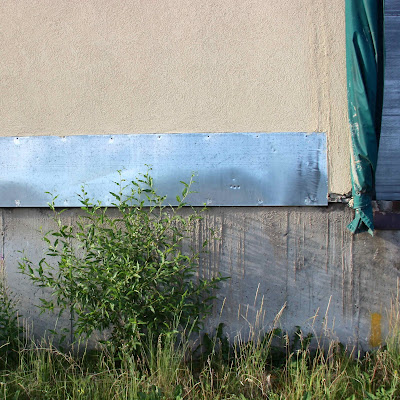 |
Year #25, dog #3.
|
With bare soil, more sunshine (less thistle), and lots of late spring and summer moisture, the old track bed has become a garden of pioneering plants. In our yards we call them “weeds” but here they are beauties—high-impact beauties in fact, given the surrounding destruction and decay.
I found one hairy evening primrose, Oenothera villosa. It's a common colonizer of open areas along the river, about a quarter of a mile away, and I bet there will be more here soon. The yellow flowers appear to open in the evening and close in the heat of midday, so who are its pollinators if not moths? Or do moths notice yellow flowers? So much to learn.
I found conflicting reports—surprising for such a widespread and well-studied plant. According to the thorough and well-documented USDA Forest Service FEIS Database, fireweed does not produce long-term seed banks. However, Wikipedia says seeds remain viable in soil for many years. In any case, fireweed produces lots, and they germinate readily in bare soil over a wide range of temperatures. Even so, vegetative reproduction is more common. Following disturbance, especially if the underground rhizomes are cut, shoots sprout and grow rapidly, sometimes reaching nine feet in height!
I collected flowering stems from some of these beauties, and took them home for closer examination … and more surprises!
Evening primroses are well-represented. True to their name, the flowers open in the evening, stay open for our morning walks, and then close in the heat of midday. Most of our species are white-flowered and moth-pollinated, hence their nocturnal habits. But there are a few yellow-flowered ones too.
I found one hairy evening primrose, Oenothera villosa. It's a common colonizer of open areas along the river, about a quarter of a mile away, and I bet there will be more here soon. The yellow flowers appear to open in the evening and close in the heat of midday, so who are its pollinators if not moths? Or do moths notice yellow flowers? So much to learn.
Nuttall’s evening primrose, O. nuttallii, is common along the dirt road. Now it's invading the newly-bare thistle-free soil. It grows to be almost shrub-like, but being a true forb, it dies back each year. The flowers are about 5 cm across, showy by local standards.
Crownleaf evening primrose, O. coronopifolia, is small perennial herb with flowers about 2.5 cm across. The lobed leaves are said to be suggestive of crowns. UPDATE: For alternative explanations, see Pat the Plant's Comment and my Reply below.
 |
| Crown-like leaves? |
Against the wall stood another flower of the night—white campion, Silene latifolia. Wikipedia notes “it is also named the Grave Flower or Flower of the Dead in parts of England as they are seen often growing on gravesites and around tombstones.” White campion is dioecious, with male and female flowers on separate plants. This one's a guy—just stamens in the flowers.
Foxtail barley is common in the Laramie Basin, often on slightly saline soils. The bulldozer brought sun into its life, and now it’s flourishing, helped by runoff from the buildling.
Finally, the surprises. Two are plants of moist habitat—surviving here due to runoff. Based on size, they must have been here for awhile. I guess I didn’t notice them behind the tumbleweeds.
 |
Narrowleaf cottonwood, Populus angustifolia. Its parents probably are among the trees along the river.
|
 |
Meadow foxtail, Alopecurus arundinaceaus, a non-native that usually grows in wet meadows.
|
The biggest surprise was fireweed, Chamerion angustifolium (other names include rosebay willowherb and blooming sally). It’s a famous fire-follower, growing luxuriously where fire has burned off both the tree canopy and ground cover, exposing bare dirt in full sunshine. But it also thrives on other kinds of disturbed sites.
I know fireweed well, from montane habitats. Surely if it were growing next to the packing sheds all these years I would have noticed it. Did it appear this year because of a fortuitous combination of factors—moisture, shade-removal, bare ground? Had its seeds lain dormant for years? Or did they blow in recently? Or did these shoots sprout from roots or rhizomes? (or did I just overlook it?!)
 |
| Purple and green, my favorite color combination. |
 |
| The long narrow pods are loaded with tiny seeds ... as I found out later. |
To be continued …














































